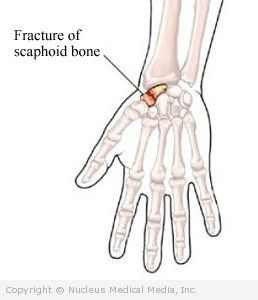(Fracture, Wrist; Broken Wrist; Scaphoid Fracture; Navicular Fracture)
Wrist fracture – Definition
A wrist fracture is a break in one or more of the bones in the wrist. The wrist is made up of the two bones in the forearm (radius and ulna) and eight carpal bones. This fact sheet will focus on fractures of the carpal bones of the wrist. Wrist fractures of the radius, often called colle’s fracture, can be found on a separate sheet.
Wrist fracture – Causes
A wrist fracture is caused by trauma to the bones in the wrist. Trauma may be caused by:
- Falling on an outstretched arm
- Direct blow to the wrist
- Severe twist of the wrist
Wrist fracture – Risk Factors
These factors increase your chance of developing a wrist fracture. Tell your doctor if you have any of these risk factors:
- Participating in contact sports, such as football or soccer
- Participating in activities, such as in-line skating, skateboarding, or bike riding
- Participating in any activity which could cause you to fall on your outstretched hand
- Violence or high-velocity trauma such as an automobile accident
Wrist fracture – Symptoms
If you have any of these symptoms do not assume it is due to a wrist fracture. These symptoms may be caused by other conditions. Tell your doctor if you have any of these:
- Pain
- Swelling and tenderness around the wrist
- Bruising around the wrist
- Limited range of wrist or thumb motion
- Visible deformity in the wrist
Wrist fracture – Diagnosis
The doctor will ask about your symptoms, physical activity, and how the injury occurred. The injured area will then be examined.
Tests may include:
- X-rays — to look for a break in the wrist bones
- MRI scan (rarely) — a test that uses a strong magnetic field and radio wave to detect a hidden scaphoid fracture
- CT scan (rarely) — a type of x-ray that uses a computer to detect small fractures or dislocations of the wrist bones
Wrist fracture – Treatment
Treatment will depend on how severe the injury but it may involve:
- Putting the pieces of the bone together. This may require anesthesia and/or surgery.
- Keeping the pieces together while the bone heals itself.
Devices that may be used to hold the bone in place while it heals:
- A cast (may be used with or without surgery)
- A metal plate with screws (surgery)
- Screws alone (surgery)
- Metal pins that cross the bone, with a metal splint on the outside of the wrist that holds the pins and the fractured bone in place (surgery)
The doctor may give you pain medicine depending upon the level of pain. Your doctor will order more x-rays while the bone heals. The x-rays will help to make sure that the bones have not shifted.
Wrist fracture – Exercises
When your doctor decides you are ready, start range-of-motion and strength exercises. A physical therapist may help you with these exercises. Do not return to sports until your wrist is fully healed.
Wrist fracture – Healing Time
A fracture of a carpal bone may take 10-16 weeks to heal. For the best recovery follow your doctor’s directions.
Wrist fracture – Prevention
To help reduce your chance of getting a wrist fracture, take the following steps:
- Do not put yourself at risk for trauma to the wrist bones.
- Eat a diet rich in calcium and vitamin D.
- Build strong muscles to prevent falls and stay agile.
- Wear proper padding and safety equipment when participating in sports or activities.

